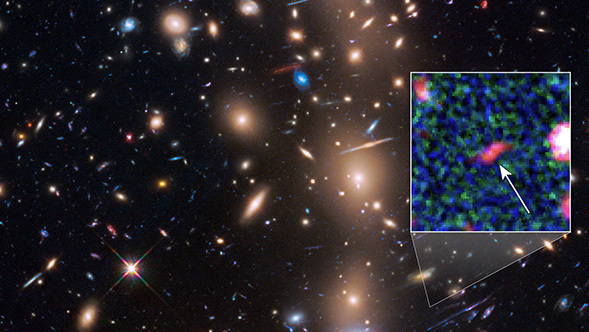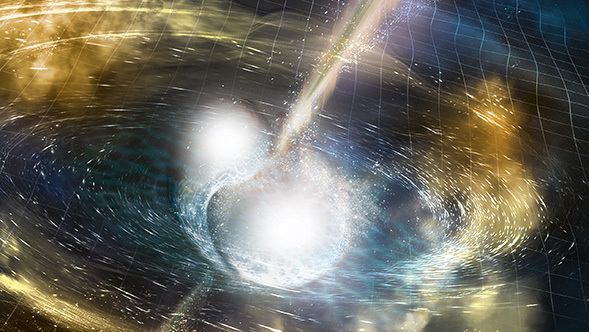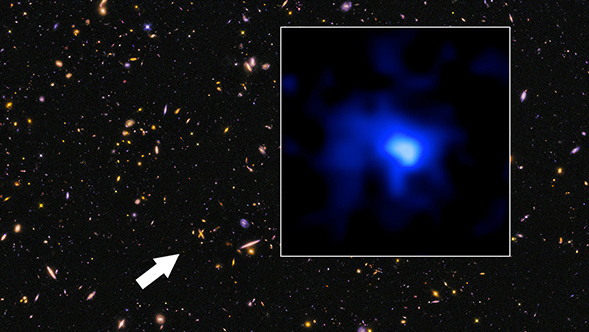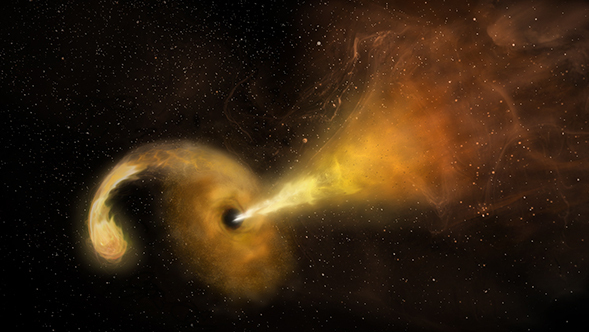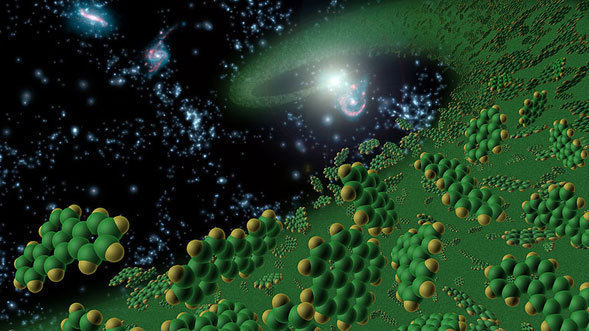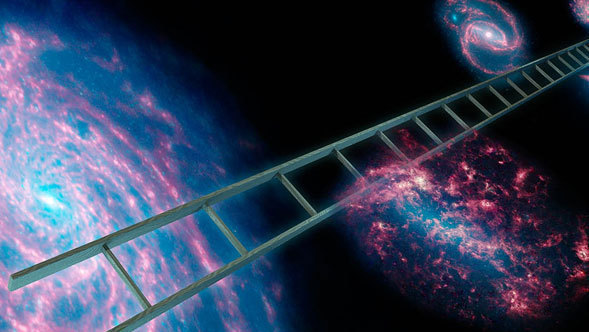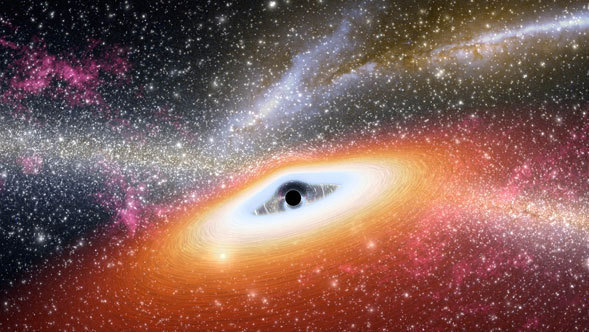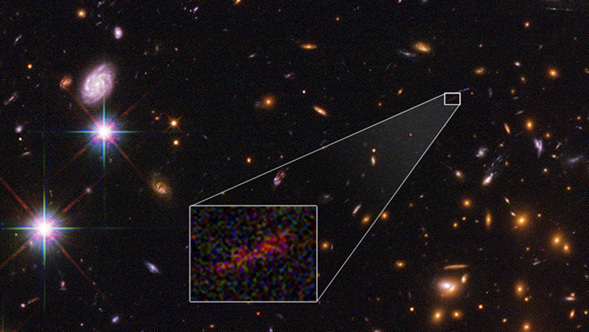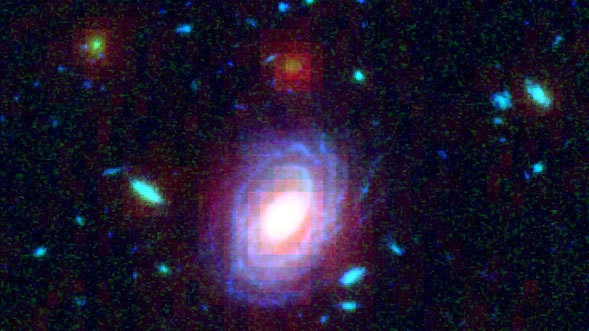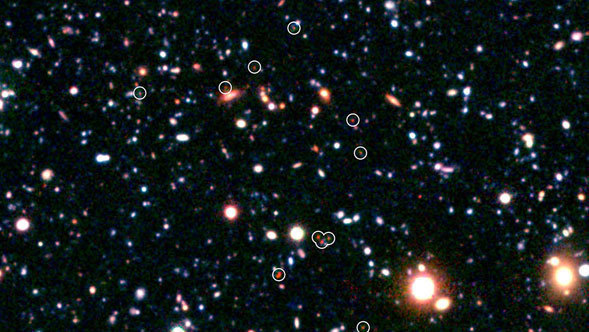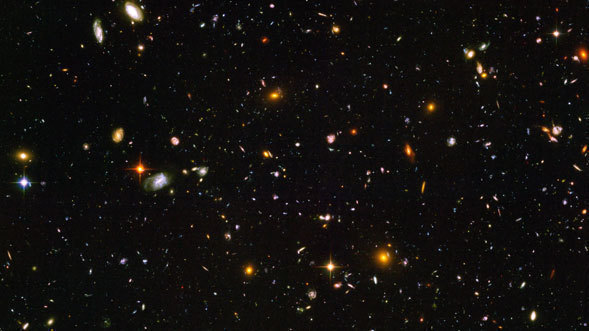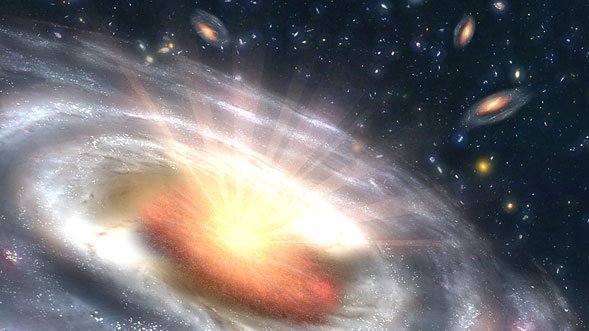In our expanding universe, to look at increasingly distant objects is also like looking back in time to see things as they were billions of years ago. The very expansion of space expands this ancient light, shifting what was once visible to our eyes ever farther into the infrared spectrum. Spitzer was built to give us a way to capture this light from galaxies that formed and grew when the universe was young.
Spitzer has helped to find some of the most distant and ancient galaxies ever detected through their feeble infrared glow. It has also helped us to detect and understand cataclysmic events in distant galaxies connected to the turbulent conditions surrounding the supermassive black holes that lie at their very centers.
Black holes aren't stationary in space; in fact, they can be quite active in their movements. But because they are completely dark and can't be observed directly, they're not easy to study. Scientists have finally figured out the precise timing of a complicated dance between two enormous black holes, revealing hidden details about the physical characteristics of these mysterious cosmic objects.
Astronomers harnessing the combined power of NASA’s Hubble and Spitzer space telescopes have found the faintest object ever seen in the early universe. It existed about 400 million years after the big bang, 13.8 billion years ago.
In just a short amount of time, NASA's Spitzer Space Telescope has bagged thousands of previously unknown dwarf galaxies in a giant cluster of galaxies.
For the first time, NASA scientists have detected light tied to a gravitational-wave event, thanks to two merging neutron stars in the galaxy NGC 4993, located about 130 million light-years from Earth in the constellation Hydra.
An international team of astronomers, led by Yale University and the University of California scientists, pushed back the cosmic frontier of galaxy exploration to a time when the universe was only 5 percent of its present age of 13.8 billion years. The team discovered an exceptionally luminous galaxy more than 13 billion years in the past and determined its exact distance from Earth using the combined data from NASA’s Hubble and Spitzer space telescopes, and the Keck I 10-meter telescope at the W. M. Keck Observatory in Hawaii. These observations confirmed it to be the most distant galaxy currently measured, setting a new record. The galaxy existed so long ago, it appears to be only about 100 million years old.
For the first time, astronomers have directly imaged the formation and expansion of a fast-moving jet of material ejected when the powerful gravity of a supermassive black hole ripped apart a star that wandered too close to the massive monster.
NASA's Spitzer Space Telescope has found the ingredients for life all the way back to a time when the universe was a mere youngster.
Astronomers using NASA's Spitzer Space Telescope have announced one of the most precise measurements yet of the Hubble constant, or the rate at which our universe is stretching apart.
Astronomers have come across what appear to be two of the earliest and most primitive supermassive black holes known. The discovery, based largely on observations from NASA's Spitzer Space Telescope, will provide a better understanding of the roots of our universe, and how the very first black holes, galaxies and stars came to be.
An intensive survey deep into the universe by NASA's Hubble and Spitzer space telescopes has yielded the proverbial needle-in-a-haystack: the farthest galaxy yet seen in an image that has been stretched and amplified by a phenomenon called gravitational lensing.
Two of NASA's Great Observatories, the Spitzer and Hubble Space Telescopes, have teamed up to "weigh" the stars in several distant galaxies. One of these galaxies, among the most distant ever seen, appears to be unusually massive and mature for its place in the young universe.
Astronomers have uncovered a burgeoning galactic metropolis, the most distant known in the early universe. This ancient collection of galaxies presumably grew into a modern galaxy cluster similar to the massive ones seen today.
NASA's Hubble and Spitzer Space Telescopes have joined forces to discover nine of the smallest, faintest, most compact galaxies ever observed in the distant Universe. Blazing with the brilliance of millions of stars, each of the newly discovered galaxies is a hundred to a thousand times smaller than our Milky Way Galaxy.
Astronomers have unmasked hundreds of black holes hiding deep inside dusty galaxies billions of light-years away.
Carnegie Institution of Washington
Balloon-borne Large-Aperture Submillimeter Telescope
Our universe is filled with gobs of galaxies, bound together by gravity into larger families called clusters. Lying at the heart of most clusters is a monster galaxy thought to grow in size by merging with neighboring galaxies, a process astronomers call galactic cannibalism.
By comparing infrared and X-ray background signals across the same stretch of sky, an international team of astronomers has discovered evidence of a significant number of black holes that accompanied the first stars in the universe.
By combining the power of NASA's Hubble and Spitzer space telescopes and one of nature's own natural "zoom lenses" in space, astronomers have set a new record for finding the most distant galaxy seen in the universe.
A new study using data from NASA's Spitzer Space Telescope suggests a cause for the mysterious glow of infrared light seen across the entire sky
NASA's Spitzer and Hubble Space Telescopes have caught sight of luminous quasars igniting after galaxies collide. Quasars are bright, energetic regions around giant, active black holes in galactic centers.
With the combined power of NASA's Spitzer and Hubble space telescopes, as well as a cosmic magnification effect, astronomers have spotted what could be the most distant galaxy ever seen. Light from the young galaxy captured by the orbiting observatories first shone when our 13.7-billion-year-old universe was just 500 million years old.
NASA's Wide-Field Infrared Survey Explorer (WISE) has found millions of dusty supermassive black hole candidates spread across the sky, along with thousands of exceptionally bright "Dust-Obscured Galaxies," or DOGs. The Spitzer Space Telescope has followed up on these extreme objects and found that, in addition to hosting actively feeding black holes, the DOGs are feverishly churning out new stars.
Seeing is believing, except when you don't believe what you see. Astronomers using NASA's Hubble Space Telescope have found a puzzling arc of light behind an extremely massive cluster of galaxies residing 10 billion light-years away. The galactic grouping, discovered by NASA's Spitzer Space Telescope, was observed as it existed when the universe was roughly a quarter of its current age of 13.7 billion years.
Black holes in the early universe needed a few snacks rather than one giant meal to fuel their quasars and help them grow, according to observations from NASA's Spitzer and Hubble space telescopes. Quasars are the brilliant beacons of light that are powered by black holes feasting on captured material, and in the process, heating some of the matter to millions of degrees.

